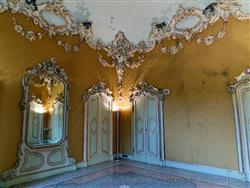|
Desio (Milan, Italy): Villa Cusani Traversi Tittoni
|
|
|
Show an other place around Milan worth a visit: |
 The origins of the villa likely date back to the 16th century when the Counts of Rho had in Desio a country villa that in the following century was required by the Royal Chamber of Milan together with their property and sold by the government to the Marquis Ottavio Cusani in 1651. The origins of the villa likely date back to the 16th century when the Counts of Rho had in Desio a country villa that in the following century was required by the Royal Chamber of Milan together with their property and sold by the government to the Marquis Ottavio Cusani in 1651.
The villa was initially used as a vast land-based production complex so that it could be considered a real estate company.
In 1777 the Marquis Ferdinando Cusani succeeded in expanding his property around the villa by acquiring the assets of the suppressed neighboring convent of San Francesco and through a series of permutations with his properties in other areas.
The current neoclassical villa was built in that era. It, and its park, had to recall the great Villa Reale of Monza ideally, also in agreement with the fact that they were located along the ancient connection between Milan and Monza.
Moreover, owner Marchese Cusani had a major role in the administration of the Habsburg Empire and his wife, Claudia Litta Visconti Arese, was a friend of the archduchess Maria Beatrice d'Este.
The design of the villa was commissioned to the important architect Giuseppe Piermarini, who also designed the Villa Reale of Monza.
In 1793 the park, originally an Italian park, was transformed into an English park, a park that was to evoke a natural and perhaps even mysterious landscape. Numerous exotic trees were planted and special structures were constructed, such as a fake cave and even a fake medieval ruin. Unfortunately, there is nothing left of those structures.
It should be emphasized that the park, at its times very famous and admired, had not only aesthetic but productive function as well! In fact, an important part of its extension was occupied by fruit trees and vines!
In 1817 the villa was sold by Luigi Cusani, the son of Marquis Ferdinando Cusani, to Giovanni Battista Traversi, an important Milanese lawyer.
This entrusted the architect Pelagio Pelagi the task of transforming the villa according to his tastes and those of that time, in order to make it more brilliant and of greater impact, to testify that the new bourgeois owners had reached the same level of nobility.
The villa was expanded on the roadside, creating the court of honor and building the pavilions for staff and workers, stylistically integrated with the villa, but separate from it by the rich railing (the latter enriched by various Carrara marble statues depicting the various human activities).
On the side to the park the relief decoration depicting the triumph of Cibele in the large gable overlapping the façade was added. The roof was also enriched with statues depicting pagan gods.
Palagi also designed a neo-gothic tower, now owned privately and home to a mineralogical collection.
The interiors were made richer and sumptuous although it was avoided creating too large spaces. The rooms on the ground floor, in order to impress the visitor, were each decorated in a different style, while the upstairs rooms were simpler, almost without decorations.
Giovanni Traversi's grandson, Giovanni Antona Cordara, inherited the villa in 1854. He built the neo-Renaissance chapel, completed in 1860.
The last important change took place in 1904, when the son-in-law of Traversi, prefect of Perugia Tommaso Tittoni, who in turn inherited the villa, built the present court of honor and erected the tomb of Giovanni Traversi.
In the second post-war period, the villa suffered a period of rapid decline. After being sold by the Tittoni family to a religious institute and transformed into a seminary, it was acquired in 1975 by the municipality of Desio, which began the restoration works.
The villa hosted many important figures: in the eighteenth century Arthur Young, English minister of agriculture, in the second half of the nineteenth century, among others, Iswolsky, Russian Foreign Minister, an Abyssinian delegation sent by Emperor Menelik, Italian King Vittorio Emanuele III.
Categories: Places of historical value of artistic value
via Lampugnani 66 |
Further pictures of Villa Cusani Traversi Tittoni in the section Photography |